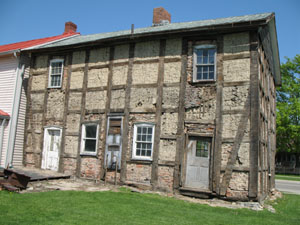By Margie Wuebker
mwuebker@dailystandard.com MINSTER -- If bare walls and wood floors could talk, what tales the old house at 163 N. Main St. would tell.

There would be stories from bygone days when the community once known as Stallostown sprang from the wilderness and travelers stopped for a beer or a hearty meal.
The building, which likely housed a tavern and guest quarters in the mid-1800s, is in the process of being dismantled by history buff Dave Hemmert of Botkins. He was hired to do the work by the current owner, an unidentified businessman in the community.
Removal of shingles and old clapboard siding from what locals refer to as the Schaffer house revealed a classic and virtually untouched example of fachwerke, a medieval construction style favored by Germans. The term, which means "compartment work," refers to heavy vertical and horizontal oak timbers mortised and pinned together in a framework.
Early settlers, like their German forefathers, favored oak for home construction because the wood does not rot or attract insects. They had no problem finding a ready timber supply as dense forests covered the countryside. Trees were felled and the beams hewn with swipes of an axe. Brick, or waddle and daub, was used to fill each compartment. The tedious process involved the placement of vertical boards into notches. Grapevines were wound around the boards to provide more stability before a final application of clay.
"The compartments had to be kept small because the brick or clay could not be supported in larger sections in those days," Hemmert says. "The sheer weight has driven the quarry stone foundation into the ground."
The north end of the house has been protected from the elements by its close proximity to the neighboring Fischer house. Even the split oak shingles on the gable remain intact.
"There is likely not another original wall of fachwerke construction preserved like this anywhere," Hemmert says. "It's a time capsule. At one time all of Minster looked like this."
He believes the B.H. Adelmeyer family ran a tavern from the house, based on the design and location.
"The house sets on the highest point along the oldest road in northwest Ohio," he says. "This was a prime location for what was known as a gasthaus in Germany."
The first floor contains two large rooms with a massive central fireplace that Hemmert says is consistent with taverns of the era. The fireplace was used for heating as well as cooking with the large chimney extending through the single room above.
"Taverns didn't have to be big back then because few people resided in the wilderness," he adds. "A couple tables and some chairs were more than enough."
Travelers would arrive, stable their horses in a barn at the side of the property and then come inside for a hot meal and perhaps a beer or something more potent. Overnight guests initially climbed a ladder to the common sleeping area and selected a spot on the floor. Narrow steps replaced the ladder in later years.
"The proprietors lived in the second downstairs room and had access to the sleeping quarters through a trap door," Hemmert says. "Your business was your home back then."
Adelmeyer owned the property for 29 years before selling it to Engel Schieper (Schaffer) in June 1865 for the sum of $700. The home remained in the Schaffer family for generations until 1980, when Florence Schaffer Boyle died. Her son subsequently sold the place, and it has remained empty except for unconfirmed reports of a friendly ghost -- a woman in a nightgown -- and unexplained lights. Some believe it is the last resident surveying her property.
The Schaffers made numerous changes over the years. Partitions created more rooms on both levels, and a kitchen with running water was added in the 1940s. Removal of wallpaper, cardboard insulation and old ceilings led to some interesting discoveries.
Smoke from the old cooking fireplace darkened many of the overhead timbers to a patina more commonly seen in smokehouses. Someone whitewashed the wood, with Hemmert noting the practice was used to stop the spread of deadly diseases like cholera, which claimed the lives of many local residents. The oldest plaster appears to be a mixture of mud and straw.
The decision to raze what he believes is one of the oldest homes in the community came last year after restoration was deemed cost prohibitive. The work must be done piece by piece given the close proximity of the structure to the neighboring Fischer house.
"Land was at a premium in Germany so settlers used it to best advantage," Hemmert says. "Placing the homes near the road and the property line allowed for side buildings as well as gardens and orchards to the back."
Hemmert intends to salvage the hand-hewn timbers and possibly use them in the construction of a workshop at his Shelby County home. He is no stranger to demolition, after tearing down another old residence across the street a decade ago.
Hemmert still would like to see a prospective buyer come forward and save the house from its ultimate fate. But that hope grows dimmer with each passing day.
"The work is taking longer than some people like because they consider the place an eyesore," he says. "Once the roof comes off, the work will go faster and everything could be down in a matter of weeks." |

